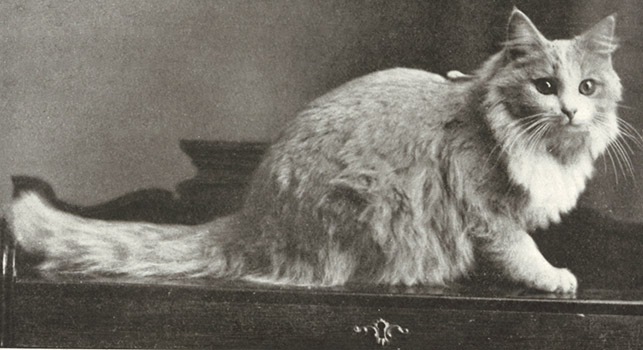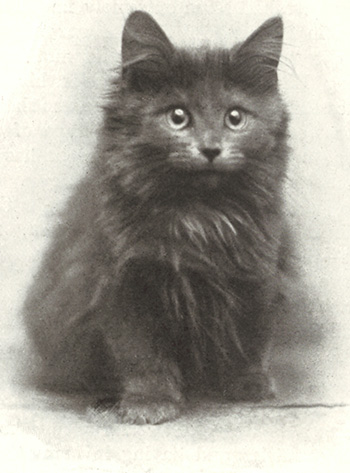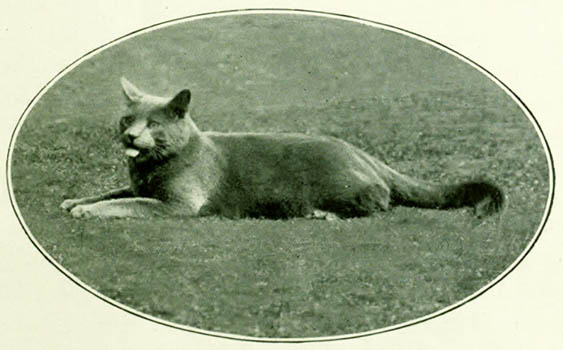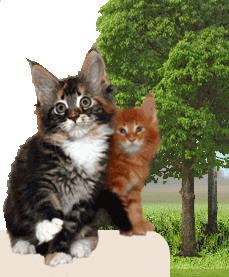FROM my earliest recollection I have had from one to several long-haired cats of that variety often called Maine cats. As to how and when they came, I would say, like Topsy, they just "growed," for their advent reaches far back beyond the memory of the oldest inhabitant.
Our own family circle was never complete without one or more cats not always longhaired, but that variety always held the place of honour.
As early as 1861 my younger brother and myself owned jointly a beautiful long-haired black, pointed with white; he bore up for several years under the remarkable name of " Captain Jenks of the Horse Marines."I have no recollection of his earlier history or advent. I fancy, however, that these cats
came into Maine much in the same way and about the same time that they did in England.

"TOBEY"
Owned by Miss Chaple.
The Maine people having had them so long, it is difficult to arouse any great enthusiasm about them there. They are much like other people they go into heroics over things they know less about.
Not until the craze for long-haired cats struck the West did they think much about selling cats; their very best would be given to their dearest friends. When I think of the number of beauties that I have had given me on my return visits because I would be good to them, it makes me wish for the good old times when the little dears were beyond price in "filthy lucre."
I think the first really important development of the cat fancy that took deep and lasting root in me occurred in 1869, when I saw for the first time a pair of blue-eyed white Persian kittens that landed, to say the least, free of duty, in a sailmaker's pocket, from a foreign vessel, which put into a seaport town for repairs after a severe storm.
This Mr. P...., being a great lover of cats, while on board the vessel making repairs, admired a beautiful white Persian cat with a family of kittens, belonging to the cook, who gave him a pair of them. They grew and were nursed with tenderest care, the female developing much the better quality in hair; but females were not highly prized at that time.
They were both kept two or three years to get a good male for a gelding. I was told that they destroyed all the female kittens; but at last they were rewarded, and then the original pair were sent to a relative in the country.
From that time on long-haired blue-eyed white kittens sprang up in most unexpected places. At intervals they have appeared and almost disappeared several times for want of care in "breeding, but with this drawback they will still frequently come forth in the same fine type.

"HENNESSY"
Owned by Mrs. Hall, Belfast, Maine.
I owned a very fine specimen called "Dot," who became a noted winner, and who came from this strain about eleven years after the kittens landed. I think he was quite as good a specimen of Persian as the one that came from the original kittens. They were both cat show winners at the same time, although "Baba" (or "Babie") was in his dotage when " Dot " was in his prime. We were not thinking of pedigrees then, but merely who had the best cat.
"Baba" at that time belonged to Mrs. Mason (formerly Mrs. Philbrook), and won the cup over everything in the Boston show. " Dot " was not at the Boston show, but won first in his class at Bangor, Maine, which was held at about the same time.
"Dot" was sent to the Bangor show to please Mr. Robinson, owner of "Richelieu," who had the management of it, and without the slightest thought of winning. He brought home a gorgeous silver butter-dish, elaborately inscribed, which sat about at least ten years before being given to the cook. Oh, that I had it now, that its picture might grace these pages!
For intelligence and affection "Dot" was by far the superior cat. I have never seen his equal. Although deaf, his other senses were so keen that we hardly realised he did not hear. He would answer to the slightest beckon, and was always watching for a call. He was quite proud of his beauty, and never failed at his mistress's receptions to speak to each person present before taking his seat in the window.
At one time some office girls who passed our house every day on the way to their work told me he was usually on the gate-post at seven o'clock in the morning to salute them and wave his plume to them. Each one stroked his head, said "Pretty kitty!" and passed on. He then took his morning roll on the lawn, and was ready for his breakfast.
His benevolence and tender feeling for cats of low degree was displayed by his keeping a cat two winters ; his protege was an example of the sad-eyed forlorn cat (one sad eye, the other closed beyond repair); spirit completely broken by neglect. As soon as the weather became cool, "Dot" would usher his sad friend into the kitchen every morning and ask for breakfast for him, then sit back on the rug the while, and with utmost satisfaction expressed in song watch the tramp cat eat it. Where he kept his friend when he was not eating we knew not ; he was invisible.
He also excelled as a traveller, making several short journeys. When with me he scorned a basket, much preferring to sit on the seat and look out of the window and incidentally entertain the other passengers by his unusual privileges in cat travelling.
He developed an unusual taste for moisture, often sitting on a garden bench through a heavy shower, while his frolics in a light snowfall were most entertaining.
Taking him all in all, I have not yet seen a finer pet cat. We sent him to rest in the happy hunting grounds at the age of ten years.
I would like to say a few words here in regard to American cat shows. We are continually hearing it stated, or seeing it written by the clubs and those who are new to the fancy, " The first cat show ever held in this country," and so forth, was, we will say, according to their light, some three years ago. That is true so far as clubs go, but large cat shows were held spasmodically in all the large and some small eastern cities as far back as the 'seventies.
I have a photograph of "Richelieu," owned by Mr. Robinson, of Bangor, Maine, who had won first in his class at Boston, New York, and Philadelphia previous to 1884, when he was shown at Bangor, Maine, in a limited show of the one hundred best cats. He was a silver or bluish tabby, very lightly
marked ; about seven years old at the time; weight about twenty pounds ; he was, as his picture shows, rather a coarse-grained variety; a drug store cat.
I know nothing of his early history; but his owner had the cat fad a well-developed case and travelled from city to city to show his cat, much as we are all doing now twenty years later.

"BLUE DANUBE"
Bred by Mrs. E.R.Pierce.
At that time Maine, near the coast, was rich in fine specimens of the long-haired cats. That was before they began to sell. I have in mind their brown tabbies.
We often hear it said by people who know them not that the Maine cats are unhealthy, that they have worms; and I have to admit it, and that they sometimes die like other cats; but here is one that didn't until he had rounded out his full seventeen years.
On page 329 is a picture of "Leo," brown tabby, born 1884, died 1901; presented to Mrs. Persis Bodwell Martin, of Augusta, Maine, by Mrs. E. R. Pierce, when he was six months old.
He lived a life of luxury and ease, having his meals served by his mistress's own hand in the upper hall, where he chose to spend his time for the later years of his life.
If I may be permitted, I would ask comparison between the picture of "Leo" and any thoroughbred brown tabby first, colour of muzzle, length of nose, size and shape of eyes, breadth of forehead,' size of ears, length of hair in the ears, and on the head. In body markings "Leo" would fall off, as his hair was so extremely long that the markings became somewhat confused.
They have had some extremely fine brown tabbies in Maine. In the summer of 1900 I bought "Maxine" there the mother of "Young Hamlet," who won over his sire "Prince Rupert" the first year he was shown. She was, or is, very much the type of the "King Humbert" stock, though she has no pedigree whatever.
It is one of Nature's own secrets how they keep bringing forth now and then, not always these fine types.
I have before me a most interesting letter from a Maine lady, one of my contemporaries.
I will first explain that Maine at that time was one of the largest ship-building States in the Union, residents of the seaport towns and cities being often masters of their own floating palaces, taking their families with them to foreign countries, and having in many towns quite social sets, like the army set or official set in other sections.
Mrs. Thomas, to whose letter I refer, was the daughter of the late Captain Stackpole, who commanded his own ship for many years, taking his wife and little daughter with him. That was before our Civil War. She says: -
"I was always very fond of cats before they had to have a pedigree. In my younger days, en route for California, we stopped at Juan Fernandez, and I got a little wild cat.
"Later on, when in Europe, I got a Manx cat from the Isle of Man ; it was a great curiosity, and not considered very handsome, with its bob-tail, and hind legs so much longer than the front ones. It came to an untimely end by running up a flue, and was smothered to death.
"The wild cat did not flourish on condensed milk, and lived but a short time. Bad luck has followed me right along, but I keep right on like an old toper, and don't know enough to stop."
In writing of her own cat, the mother of "Swampscott," she says:-
"I cannot tell you much about my cat's pedigree only that her great-grandfather was brought to Rockport, Maine, from France; he was a blue-eyed white."
This line of whites, while in the same locality, are quite distinct and unrelated to the first whites mentioned, of which "Dot" was given as a type.
But her reference to her early exploits with Manx cats clears the air as to how these different varieties first got root in Maine. This instance is only one in many where pets of every variety were bought in foreign ports to amuse the children on shipboard ; otherwise, as in one case I can call to mind, the children would make pets of the live stock carried to supply the captain's table with fresh meals chickens, lambs, etc. until it would be impossible to eat the little dears after they
were served by the cruel cook.
Therefore birds of plumage and singers, cats, dogs, and even monkeys, found their way to nearly all the coast towns many more in the past than at this time, when sailing vessels have passed their usefulness as money-making institutions, and those that do go out are not commanded by their owners; paid captains, as a rule, cannot take their families with them, and the supply of cats from that source has been cut off for many years, so those we find there now can safely be called natives.
Up to this point I have been writing of the cats of the long, long ago, and perhaps only interesting to myself, being as full of plain facts as Gradgrind.
Before coming down to some of the fine cats of the present day, I will say that I am told by an eye-witness that on a little island quite well off the coast which is inhabited by only three families, and where a few gentlemen have a quiet nook to fish in summer, they found pure white Persian cats with the most heavenly-blue eyes. So far as is known, no other cats are on the island. I had the promise of a pair last year, but cruel fate had visited them in their sheltered nook, and the kittens that year died. The promise still holds good, and I do not want to believe it a "fish story." Time alone can finish it.
I really know nothing of the cats that are said to be found on the islands ; but no doubt they are much the same as those found all along the New England coast.

"LEO" BROWN TABBY.
Owned by Mrs. P.Martin.
(Photo: Hunton, Hallowell.)
For a long time the long-haired cats seemed to be confined mostly to the coast towns and cities; but the giving their best to "their sisters and their cousins and their aunts" have spread them inland, as well as scattered them over nearly every State in the Union. They thrive as well as any other long-haired cat. No doubt they do still better in Maine, very like it while at their summer home on the coast of Maine. The fad
is contagious, and if they have the fever running very high they
send back east to their "handy-man" to get them a long-haired cat, and
these cats become popular. Clubs are formed to discuss points and
exchange knowledge, shows become a necessity, large premiums are
offered, numerous valuable specials become a feature, cats must be found
to fit them, the home market at a low figure is looked over, many Attic
treasures are brought out, and have often but the difference comes from the fact that they have the freedom of living a natural life, without dopes or over-coddling. Their offspring are beautiful, because they are from their own choosing, and not from compulsory mating often distasteful, no doubt.
About 1895 or 1896 the cat fad struck the Middle West. The time was ripe for its development. The high, the low, the rich, the poor have all felt its force, as the real love of animal pets is no respecter of persons, and this fancy has made the whole world kin.
A few people who had never seen a cat show in their native land "go across," attend a cat show, or pick up a cat at a bargain on the streets of London ; they "fetch" it home, and, lo! their neighbour has seen something tipped the scales in favour of the Yankee cat. We all turn green with envy. Before another
show we must import a ready-made winner at any cost! In the meantime, the demand for the home-grown article is increasing, and prices are getting much inflated, the dealers in large cities keeping their buyers busy in the New England field during the fall and winter months. But the stock of kittens has been
looked over by the summer residents or visitors; the real cream disappeared with the first frost to some winter homes in the big cities; the dealers get what is left at almost any price they please to pay, many of the specimens being indifferent, and some, no doubt, mongrels.
In the last few years I have known less of the Maine cats, except through the shows and a few that I have owned myself, which have not been shown much or proved remarkable in any way ; but among the gems that have shown out with more or less brilliancy when on the bench we find "Cosie," a brown tabby,
taking first and special for best cat in show in New York, 1895. Mrs. Lambert brings now somewhat scattered, but all showing great, strength, form, bone, and sinew.
Mrs. Chapman's "Cusie Maxine" - a fine type of brown tabby, dam of "Young Hamlet," who won over his sire "Prince Rupert" was also a Maine cat.

"YELLOW H. 14th BEAUTY."
Owned by Mrs. Staples.
Mr. Jones, of The Cat Journal, has from time to time had some fine brown tabbies of out "Patrique " in New York in 1896 blue, and a nice one.
"King Max" first brought out by Mrs. Taylor won in Boston first in 1897-98-99, only to be beaten by his sire "Donald " in 1900.
Mrs. Mix has shown a fine Persian type from Maine called the "Dairy Maid." I believe she has also "Imogene," from the same place a tortoiseshell.
Mrs. Julius Copperberg's "Petronius," of whom we all expected great things, was from a line of creams coming well down from a fine cream brought from some Mediterranean port by one Captain Condon about fifteen years ago. I have secured for friends several kittens from his cat's descendants, which are the Maine stock, winners at some of the larger shows.
A fair representative of the whites, who has acquitted himself well at the various shows in competition with large classes, is "Swampscott," owned by Mrs. F. E. Smith, of Chicago. He comes from Mrs. Georgia Thomas's white cats at Camden, Maine, his maternal greatgrandsire coining from France.
"Midnight" a younger black cat, winning second at Cincinnati to a cat from New Hampshire in better coat, and second in Chicago in 1901 in large classes has since become a gelding and pet of Mrs. J. J. Hooker, of Cincinnati. He comes from a line of blacks owned by a retired sea-captain named Ryan, who had at one time four generations of black cats. They loved their cats like babies, and for years looked for people suitable to give their kittens to. I have been the flattered
recipient three times in the last dozen years of these beautiful black diamonds.
"Antonio," a gelding, now owned by Mrs. A. B. Thrasher, of Cincinnati, Ohio, is also a fine representative of this stock. See photograph.
In the last few years, since cats there are at such a premium and old age getting nearer every day, these good people have hardened their hearts, and now sell like others to the highest bidder.
I can also think of "Peter the Great," a neuter cream and white, owned by Mrs. Carl Schmidt, shown at Detroit, Michigan, 1901. Also "Black Patti" originally owned by Miss Ives and "Rufus," both Maine cats, now owned in Detroit, and winners in some of the Middle West shows ; and many, many
other winners whose place of nativity is a sacred secret with their owners, which we will not wilfully expose to public gaze until our native cats have been accorded the place that is due to them.
I would like to tell you of some of the handsome geldings in Maine. No cat is too good for a pet with them. They may be seen on nearly every lawn or stoop ; but as that is a little out of the province of this story I will only describe one a beautiful smoke owned by Dr. and Mrs. E. A. Wilson at their beautiful home in Belfast, Maine. He is now ten years old ; his mask and feet are black, or nearly so ; his hair is very dark, rather brownish at the tip, but as white as snow at the skin. I have begged them to show him at Boston or New York. The answer is always the same : "Not for any amount of money or prizes. 'Tags' wouldn't like it ; he would be unhappy. Wouldn't you, 'Tagsie'?"
The smokes have not been well developed there yet. In a letter lately received in regard to that variety, I am told that one of the regular agents said he found only about one in 200. The silvers and chinchillas are not common. The strong colours predominate, whites, blacks, blues, orange, and creams, tabbies also being well divided and distributed along the coast, and for quite a distance back, perhaps sixty miles or more ; but I have not known of -their appearing to any extent in the northern portion of the State, which is less thickly settled.

MRS. BAGSTER'S ("DEMIDOFF.")
(Photo: Cassell & Company, Limited.)
Having had this fancy from my infancy and before it became a fashion, I took kindly to all the new developments. I have since had some experience with imported and kennelbred cats, and from time to time had opportunities of seeing the best we have in our shows, and I fully believe that cats that have their freedom, as most of the Maine cats have for the greater part of their lives, are healthier than kennel cats can be. The cool climate and long winters, with clean air full of ozone, is what is needed to develop their best qualities, and, with a few years of careful breeding for types, they would be able to compete quite successfully in an international cat show.
F. R. Pierce.
.....





